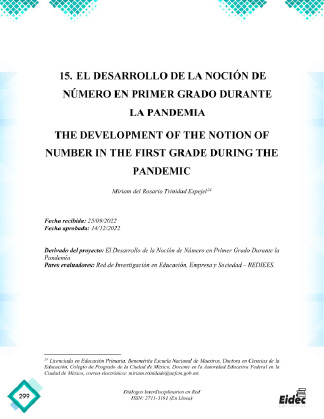XV. THE DEVELOPMENT OF THE NOTION OF NUMBER IN FIRST DEGREE DURING THE PANDEMIC
##plugins.themes.bootstrap3.article.main##
Abstract
Concise description, the reason and objective of the manuscript, the most
Highlights and main conclusions. It must be written impersonally: "the
present work analyzes
The construction of the notion of number is a functional knowledge, the number is
a tool that allows acting in daily life and interpreting the phenomena of
quantitative way.
During the 2021-2022 school year, it was observed that children who entered first grade
degree, the pandemic affected their learning, many of them had not attended in person
to preschool, had only worked remotely or did not work at all; this impacted the
construction of the notion of number, in some cases they did not even perform the oral count.
For the first grade attractive teaching strategies and resources were used, during
face-to-face classes and in meet so that they will find the relationship between numeral and
significant, with concrete experiences, the result of interaction with their peers.
Qualitative research aims to: analyze the strategies and resources
most suitable didactic for the construction of the notion of number in first grade, during
the pandemic.
In the results it was observed that when working the stages: concrete, graphic and abstract,
allowed children to find meaning in numerals, regardless of whether the work was
through meet or in person. The conclusions highlight that for children to
could develop the notion of number, it was necessary to carry out attention exercises –
observation, classification, seriation, correspondence, reaching the graphic representation and
after solving problems related to the notion of number.
Download Statistics
##plugins.themes.bootstrap3.article.details##
Number, Classification, Seriation and correspondence.
un enfoque constructivista de las matemáticas en educación infantil. Jaén, España:
Enfoques educativos.
Alsina, Á. (2006). Cómo desarrollar el pensamiento matemático de 0 a 6 años. Barcelona,
España: Octaedro-Eumo.
Alsina, C., Aymerich, C., Barbe, C. (2008). Una visión actualizada de la didáctica de la
matemática en Educación Infantil. UNO, 47, 10-19.
Balbuena, H. (1996)
Block, D., y Álvarez, A. M. (1999). Los números en primer grado: Cuatro generaciones de
situaciones didácticas. Educación Matemática, 11, 57-76.
Chamorro, M. C. (2006). Didáctica de la matemática para la educación infantil. Madrid,
España: Pearson Educación.
Martínez, J. & Rodríguez, J. (2010). El currículum y el libro de texto. Una dialéctica siempre
abierta. En Gimeno Sacristán (Ed.), Saberes e incertidumbres sobre el
currículum (pp. 246-268). Madrid, España: Morata.
Parcerisa, A. (1996). Materiales curriculares. Cómo elaborarlos, seleccionarlos y usarlos.
Barcelona, España: Graó.
SEP (2014). Desafíos matemáticos. Libro para el alumno. Primer grado. México, Comisión
Nacional de Libros de Texto Gratuitos.
SEP (2017) Aprendizajes Clave para la Educación Integral, Plan y Programas de Estudio
para la Educación Básica.





